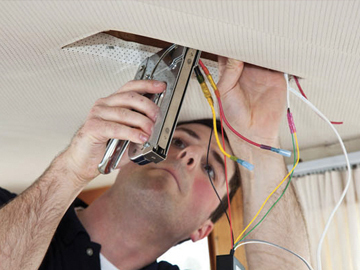
Energy Focus manufactures LED tube lights, which address a huge portion of lighting in the commercial sector. Our lights already secure major energy and cost savings for our customers, and it’s as easy as changing a light bulb. We’re trying to push our technology further, specifically in the direction of greater connectivity and widespread sensors, for more energy savings and more value.
As we plan for the proliferation of the “Internet of Things”, we want to make sure that “changing a light bulb” is still a simile for simplicity. If we nail the installation, we’ll not only dramatically increase our customer base, but we will show the market how it should be done. Currently hooking up connected lights is quite difficult. Each light fixture or bulb needs to join the network on its own address, and then mapped to physical location and logical lighting zone. Very cumbersome and hard to maintain.
How could you roll out the simplest installation possible for a connected lighting system?
A) How would the lights and sensors be installed?
- Do you integrate sensors into lights or fixtures, or have them installed separately, and why would one be better than the other?
- Popular sensors today include occupancy detectors and light-level detectors but you can propose any sensor you think of!
B) How would each bulbs, fixtures, and sensors get mapped or learn their function?
- All lights will be connected to a network; once that network is set up, how does one make it functionally useful?
- Components can be programmed manually or learn automatically but in either case, what kind of tech or concept can be used to make the roll-out fast, simple, and accurate?
C) What complementary systems or resources would be needed to make your installation plan a reality?
- Does an installer use special hardware to make deployment easier, faster, or more automatic?
- Can a phone or laptop application provide the same functionality, giving end-users the ability to self-install/reconfigure?
Highly Suggested: Sketches, drawings, mock-ups, charts, graphs or any other visuals that better explain your concept. Installers can do some roll-out, but the less end-users have to do to use the system, the better.
CRITERIA:
- Try to avoid ideas that rely consistently on the cloud, or another system that could go offline and knock out the lights.
- We're looking for outside the box ideas so don't be afraid to get creative (a solution we're currently looking into is a using a Roomba vacuum robot to trace a room before light installation!)
- Your idea should be focused around simplifying the logistics of installing connected light systems, and doesn't need to be heavy on technical details (they're appreciated if you have them!)
-
Submissions will be graded on the following criteria:
- Meets Deliverables
- Creativity
- Clarity
will receive $150 each
will receive $50 each
| $150.00 |

|
Nicholas Scianmarello California Institute of Technology | |
| $150.00 |

|
Alexander Arseneau The Ohio State University | |
| $150.00 |

|
Pedro M University of Providence | |
| $150.00 |

|
Eileen Ly Brown University | |
| $150.00 |

|
Joseph Illingworth University of Utah | |
| $50.00 |

|
Joseph Scott Tufts University | |
| $50.00 |

|
Joseph Maekalson Australian National University | |
| $50.00 |

|
Devin Gustus Pasco-Hernando State College | |
| $50.00 |

|
Nhi Bui University of Georgia | |
| $50.00 |

|
Garath Fulks Texas A&M University |
